IPOH, Dec 12 – Seriously sick non-Covid patients have been deluging the general hospital in Ipoh for the past seven months, with beds packing the corridor of its struggling emergency and trauma department (ETD).
Severely ill patients, including those on ventilator support, now wait in the ETD’s Red Zone (Critical Zone) at Raja Permaisuri Bainun Hospital (HRPB) for an average of two to three days – sometimes even up to six days – for admission into scarce critical care beds, doctors say. One semi critically ill case was even stranded in the public hospital’s emergency department for an entire week last month.
Some patients with poor prognosis have died in a general medical ward due to the lack of beds in a critical care unit, said an HRPB medical officer, who deemed at least one case as a preventable death.
HRPB doctors attributed the long waits of up to 168 hours for ward admission to a surge of non-Covid patients with advanced chronic conditions, due to postponed follow-up appointments during the Covid-19 pandemic, as well as a shortage of doctors and nurses amid staff resignations.
The most common non-communicable diseases (NCDs) that critically ill patients are presenting at the ETD this year, say HRPB doctors, are heart disease, kidney failure, and stroke.
“Six to seven days’ waiting time is abnormal; it’s never been like that,” HRPB medical officer Dr Bob (pseudonym) told CodeBlue in an interview.
He explained that pre-pandemic, the longest that patients would wait for a bed in a ward – either in general, or in the intensive care unit (ICU) or high dependency unit (HDU) – was 24 hours. Back then, most patients stranded in the ETD, or ED, from the day before the morning case handover would have already secured beds in a ward by the time of the handover.
“Now, shockingly, some of the ventilated patients are still stranded in ED – the reason, no bed in the ward. These are mostly ventilated patients or critically ill patients needing an ICU or HDU bed.”
The ETD is meant to stabilise critical cases for immediate admission into the respective inpatient ward – either the ICU or HDU, or for trauma cases, operations in the operating theatre – as the emergency team is not trained to provide the necessary medical treatment for such severely ill patients. Basically, very sick people are not supposed to be in the emergency department.

CodeBlue’s report on the severe congestion in the emergency department of HRPB – a government tertiary hospital and main referral centre that serves the entire state of Perak – comes after the Auditor-General’s 2018 report first disclosed that ETDs, specifically, in public hospitals in Malaysia were understaffed, overcrowded, and underfunded. This was before the Covid-19 pandemic.
The case of HRPB that began worsening in May 2022, according to doctors, illustrates the stark impact of Malaysia’s NCD crisis that likely worsened after two years of lockdowns disrupted care.
Doctors working on the ground in HRPB appeared resigned when speaking to CodeBlue, amid daily scrambles for empty beds in wards, even as they acknowledged that the quiet crisis in the strained emergency department of the Ministry of Health (MOH) hospital is affecting patient care despite their best efforts.
CodeBlue visited Ipoh GH’s emergency room last month, interviewed four HRPB medical officers (all of whom spoke on condition of anonymity as civil servants are prohibited from speaking to the press), and reviewed internal hospital data for this story.
Two Patients Died In General Medical Wards After Over Four Days’ Stranding In Emergency Department

Based on Dr Bob’s review of HRPB’s bed management unit (BMU) data from October to November this year, one patient was stuck in the ETD’s Yellow Zone for seven days by November 8 before admission into a ward. Cases in BMU data are listed for ward admission; step down care, including to district hospitals; or discharge.
Six patients were stranded for six days in the ETD – including three in the Red Zone – by October 26, 27, 31, and November 30. One of the stranded Red Zone cases was intubated.
Eighteen patients were waiting for five days in the emergency department between October 11 and November 9. This includes 11 in the Red Zone, two of whom were intubated. Among the 18 cases listed as stranded for five days, two appeared twice on two consecutive dates as Day Five strandings.
Day Four stranding in the ETD affected 42 patients between October 12 and November 30. This included at least 22 from the Red Zone, including at least one intubated patient by October 17.
In total, 67 patients were stranded for four days or longer in HRPB’s emergency department from October to November.
From October 11 to November 29 this year, 53 patients were waiting in the ETD for more than 24 hours, including 23 in the Red Zone. Among the 23 cases, six were intubated. Between October 11 and November 30, at least 776 cases were stranded for less than 24 hours.
According to Dr Bob, a 42-year-old woman, who died last October 16 in a general medical ward, had been stranded for four days in HRPB’s emergency department before ward admission. Her cause of death was listed as acute coronary syndrome; she had hypertension and uncontrolled diabetes, among other underlying issues. In another case, an 81-year-old woman, who died in a general medical ward last July 9, had waited over five days in the ETD at the Ipoh general hospital for ward admission.
Data from MOH’s health management information system (HIS) at HRPB on morbidity and mortality for inpatients, as sighted by CodeBlue, is missing for most months from 2020 to 2022, showing “no record found”. This is different from some months that recorded zero inpatient deaths. Dr Bob claimed that data from MOH’s HIS isn’t accurate, including records of purportedly zero mortality, because “the data is not captured in the system or not entered”.
2022 Red Zone Arrivals (Mostly Non-Covid) Expected To Exceed 2021 (Mostly Covid)
According to internal HRPB statistics sighted by CodeBlue, the hospital ETD’s Red Zone last year – when Malaysia’s Covid-19 epidemic was particularly brutal with the severe Delta wave – saw 14,700 outpatient arrivals.
Shockingly, the number of Red Zone outpatient arrivals at HRPB this year as of November – mostly non-Covid cases, according to doctors – was nearly as high at 14,109. Going by the trend of more than 1,000 arrivals every month at the Red Zone this year, the total number for 2022 will likely exceed 2021.
The 14,109 Red Zone outpatient arrivals in HRPB this year from January to November is 73 per cent higher than the 8,168 arrivals in 2019 in the same period, or 5,941 more arrivals.
The total number of outpatient arrivals in HRPB’s ETD across triage codes dropped during the pandemic years of 2020 and 2021, before rising to 86,757 this year as of November. But the ETD arrivals in 2022, as of November, are 41 per cent lower than the same period in 2019 that recorded 147,659 arrivals. This is equivalent to a decline of 60,902 arrivals.
This means that even though much fewer people are visiting the emergency department of Ipoh’s general hospital this year in the aftermath of the acute phase of the pandemic, compared to pre-pandemic 2019, far more are turning up severely ill now with chronic conditions.
The kind of critical cases entering the ETD at HRPB this year, Dr Bob said, are people with lung infection and community-acquired pneumonia who need oxygen therapy and ventilator support; those with end-stage renal disease or acute kidney injury who need dialysis; or heart patients on inotrope who go into septic shock if they get an infection.
“Now, they’re more sick, so they’re waiting longer for beds in ICU and HDU.”
Dr Bob said two to three days’ average waiting time for patients to get admitted into a ward was “unacceptable”: “The longer they stay in emergency, it’s suboptimal care. It’s common sense.”
He said HRPB started adding back “virtual” beds in wards, or extra beds that can be added or removed, from around June this year. During the pandemic, the number of beds in normal wards was reduced for social distancing (non-medical wards at the time were turned into Covid wards).
Beds In Open Corridor; Broken Equipment; Absconding Patients
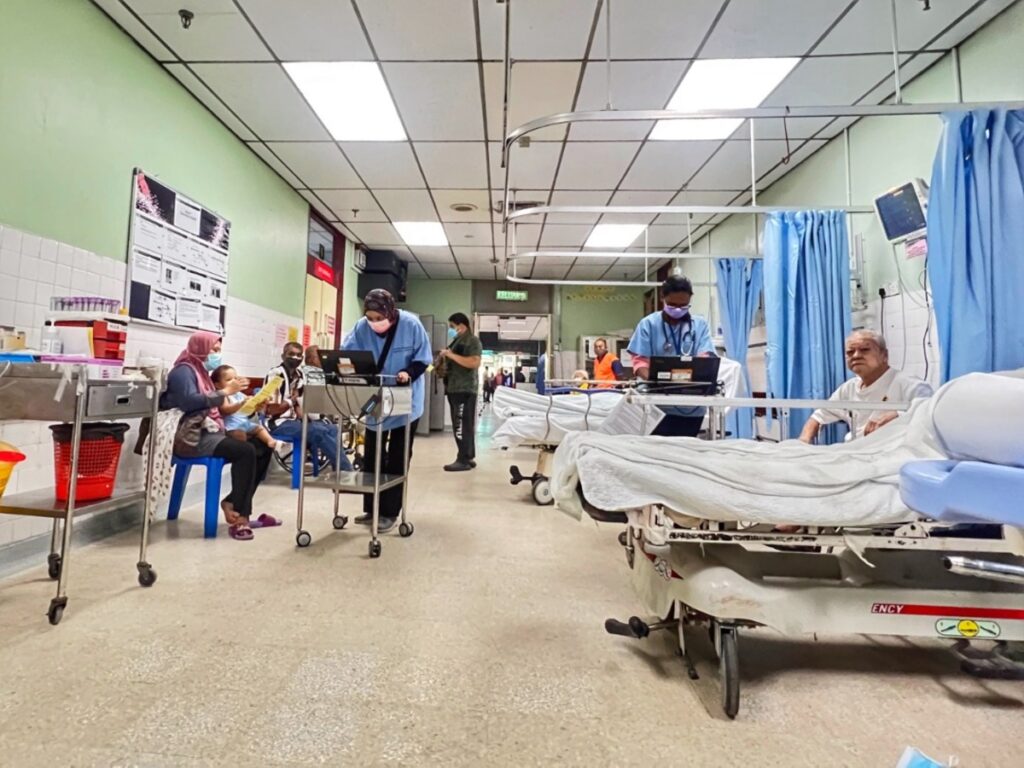
In visits to HRPB’s ETD last month, CodeBlue observed patients on beds lined up along the busy main corridor, a public area, with patients, hospital staff, and visitors passing through. Some patients waited on plastic chairs opposite the beds to be seen by a doctor or to get their test results. These are all Yellow Zone cases overflowing from the room inside the emergency department.
HRPB medical officer Dr Natasha (pseudonym) said by right, hospital beds should not be placed along the open hallway of the ETD to be used as some sort of “mini ward”.
“But sometimes, we put cardboard at the back there for stroke patients or heart attack patients who are stable, based on risk stratification,” Dr Natasha told CodeBlue in an interview.
When a bed is damaged, HRPB staff use cardboard, extra pillows, or bed sheets under a patient’s head to prop up the patient because those with stroke need feeding in a propped up position to avoid aspiration, while patients with a weak heart and water in the lungs need to be propped up so they can breathe more easily, Dr Bob explained. Some beds with spoiled springs will still be used with cardboard underneath the mattress.
Dr Natasha stressed that cot beds with railings are needed for elderly patients to prevent them from falling, saying: “So at times, that is also a delay for admission. Even though there is a bed, there’s no bed suitable for them.”
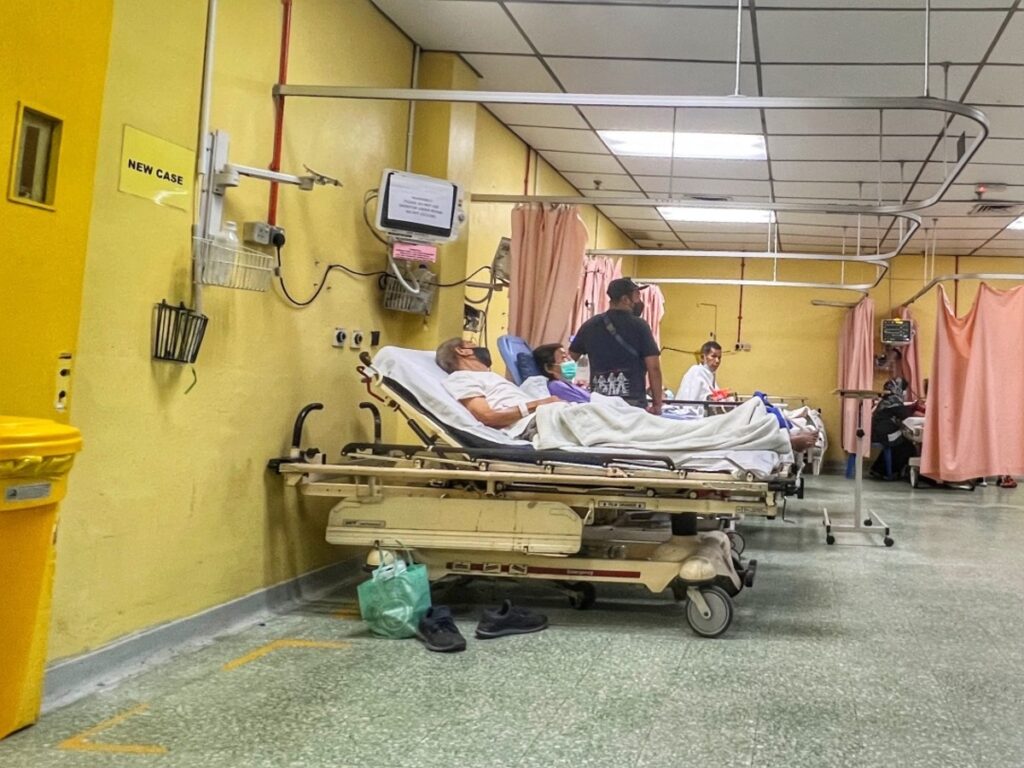
During CodeBlue’s visits, one patient was observed on a bed without railings on one side in the ETD’s main corridor. In a Yellow Zone room, Yellow 1, a broken vital signs monitor above a patient – which is meant to show the patient’s blood pressure, pulse rate, and O2 saturation rate – had a piece of paper over it that read: “Warning!! Please do not use. Monitor under repair”.
Dr Bob said that based on the report number, the vital signs monitor fell out of order this year. As such, the nurse goes around with a portable machine during her rounds to track the patient’s vital signs.
He said some HRPB doctors have requested and received donations of hospital bed railings, mattresses, and pillows from non-governmental organisations (NGOs). New hospital beds are too expensive for NGOs to contribute, so staff make do with problematic beds that hospital support services try their best to repair for use as long as possible.
Perak has the oldest population in the country. The state constituency of Pasir Pinji in the state capital city of Ipoh has one of the highest old-age dependency ratios in Malaysia.
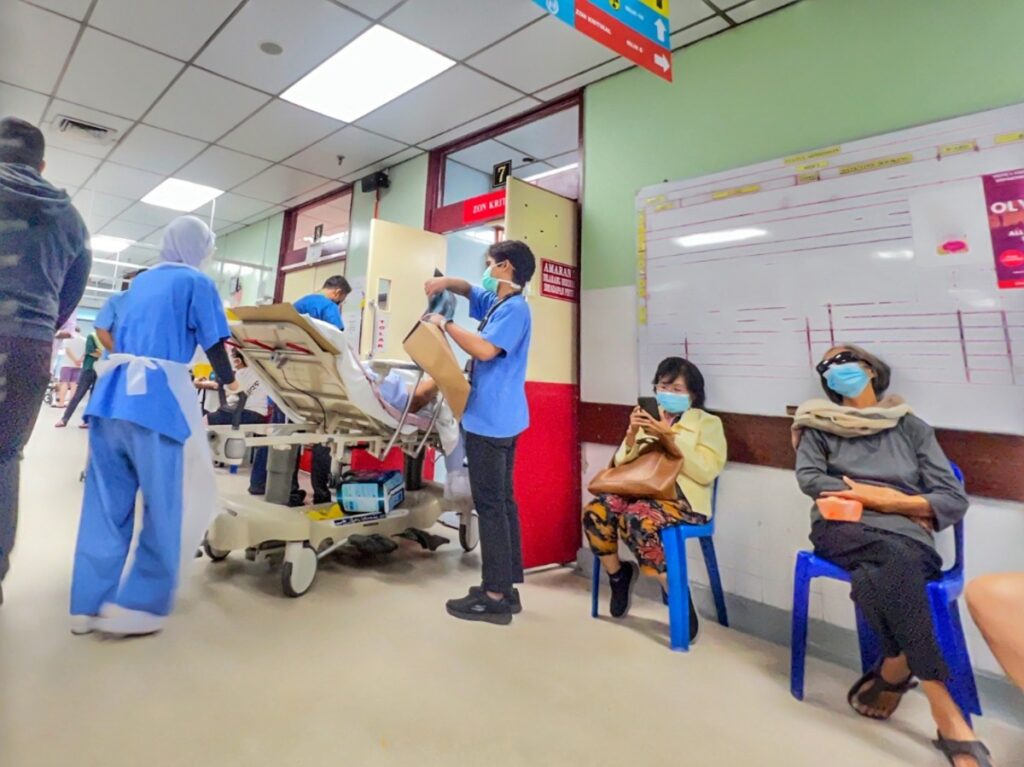
Like Dr Bob, Dr Natasha said currently, patients are stranded in the emergency department for about three days before admission to a ward. They wait about three hours to be first seen by a doctor, although she pointed out that on one particular Monday, patients waited five to six hours to be seen and five days for admission. On a “very rare” good day, patients waited one to two hours to be seen.
“It’s unusually long,” she said, noting that during pre-pandemic times, patients waited for one and a half days at the most to get a bed in a ward.
“If they came on Monday morning, by Tuesday afternoon, they could get a bed. That was the longest patients had to wait – maybe because they waited for referrals or they got further issues in emergency, but nowadays, it’s longer than usual.”
According to Universiti Sains Malaysia’s Department of Emergency Medicine, the Red Zone (Critical Zone) is for critical cases seen “immediately”, as they require life-saving intervention. The Yellow Zone (Semi-Critical Zone) is for high-risk cases seen within 30 minutes, while the Green Zone (Non-Critical Zone) is for non-critical cases seen within 120 minutes.

Dr Natasha said about 80 to 90 medical patients are stranded for more than 24 hours on average every day, comprising approximately 50 in the Red Zone and up to 40 in the Yellow Zone. The medical department handles nearly all kinds of cases, except surgery or delivery.
Only one ward doctor is posted to each zone in the ETD to review all referrals for medical cases, Dr Bob said. These reviews – mandatory for all patients as a rule, like in other units – are done until 8am the next day. Then, the ward specialist will review these patients again.
“Multiple reviews also take time and cause delay in making and confirming the diagnosis before the ward admissions,” he said.
Some patients have even absconded from the ETD, unable to wait up to four to six hours to be seen by a doctor.
“There are times when the doctors manage to see [the patients], but they can’t wait for the results. For the doctor to come back again, see them again, check them, they tend to leave. Or sometimes, they cannot wait for admission, they get fed up and leave, they get tired,” Dr Natasha said.
A String Of Delays Leads To ‘Sub-Par’ Care
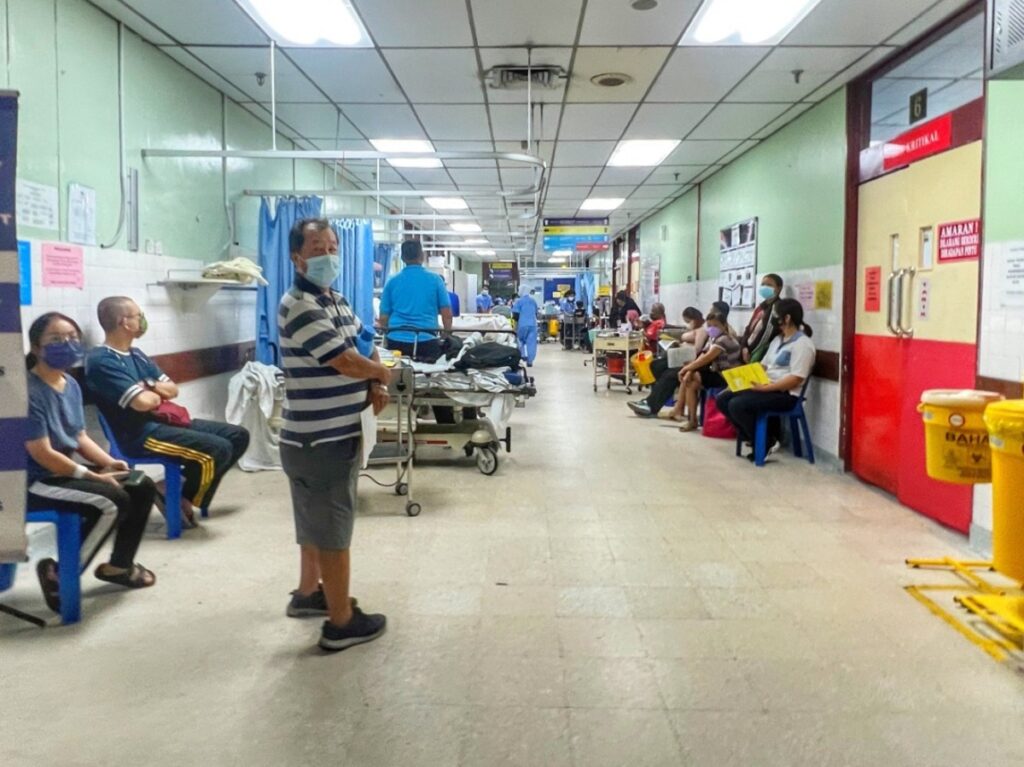
When asked if patient care has been affected by long waiting times, Dr Natasha replied, “definitely”.
She highlighted patients waiting on chairs in the ETD to be seen by a doctor. “You don’t know what’s wrong with them. They may be having some heart issues or even a lung issue — we wouldn’t know because we haven’t asked what is necessary.
“Since we’re delaying to ask them what’s the problem, we take blood late, we send it late, it comes back late, the management is late.”
Dr Natasha stressed that patients still need care even if they’re able to sit up, saying: “It’s not the best optimal care; it’s sub-par.”
She said the four main conditions patients are presenting at the ETD are heart disease; kidney problems, chronic kidney disease, and dialysis patients; severe upper gastrointestinal (GI) bleeding; and stroke. Occasionally, HRPB gets Covid and dengue cases, or sometimes drowning or poisoning.
The HRPB medical officer attributed the long waiting times in the emergency department to insufficient doctors, facilities, and beds.
“Even to resus patients sometimes, we don’t have enough beds. Patients are sitting, waiting to be attended to, they don’t have a bed.
“Doctors are less, less housemen. Two zones, one houseman covers. House services are the front — take blood, ask a few questions – but I think there are very less housemen, very less MOs (medical officers) now. They tend to quit.”
Unmonitored In No Man’s Zone: ‘Not My Job, Not My Patient’
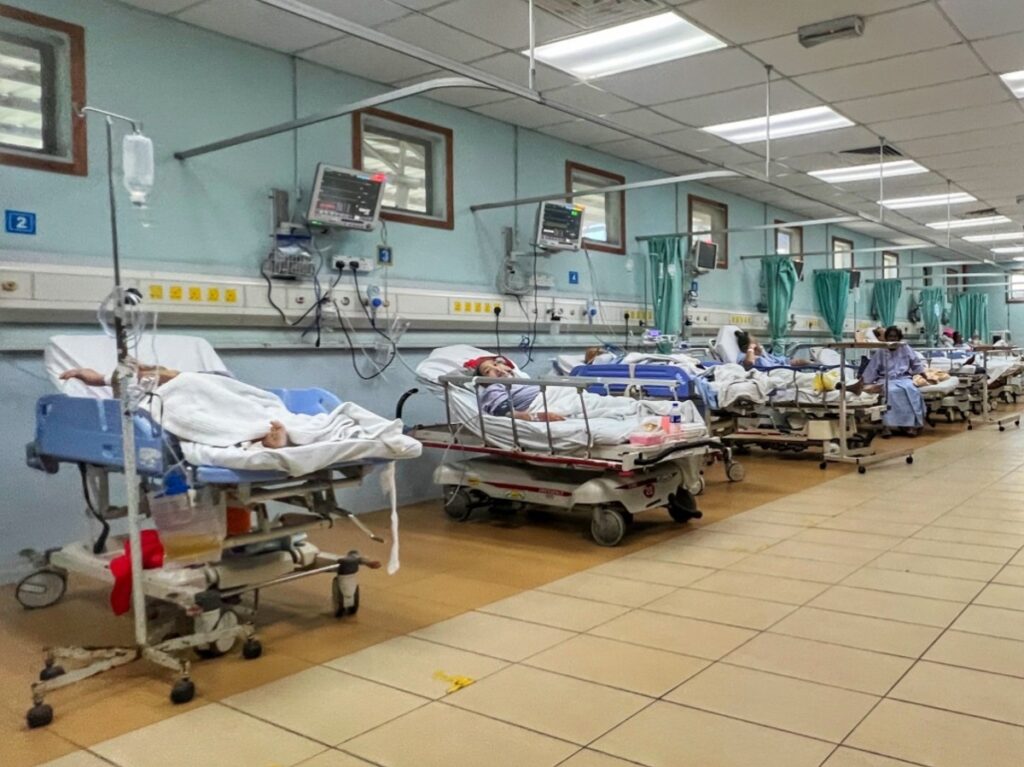
Dr Bob said the main concern with patients waiting for days in the ETD is the quality of care and monitoring, as responsibility for these stranded patients is shunted between the emergency team managing a congested emergency room and ward doctors overwhelmed with a constant flow of incoming new cases.
“The main issue is interdepartmental conflict,” he said.
“The ED team actually — they don’t monitor, they don’t review the results. The staff don’t monitor the stranded patients. They leave it to the ward doctor to come and review. So it looks like a no man’s zone for some patients.”
He added that it’s easy for nurses to monitor a patient’s vital signs like blood pressure, pulse, and temperature, but monitoring the patient’s clinical condition, progress, improvement, and blood test results is sometimes missed by doctors.
“This is the one that sometimes falls into no man’s zone because the primary doctor from the ward, they also have their own new cases every day. They think the patients are being monitored by another person, but the ED doctor also thinks this person is being seen,” Dr Bob said.
He explained that some patients waiting in the ETD deteriorate within one to two days, after initially appearing stable to ward doctors who take the initiative to come down and review patients in the emergency room.
“They’re, like, confident at first when they see the patient, ‘okay, this patient will be stable, I will just do some superficial review’. Then, one to two days later, the patient got some new problem – BP drop, urine not coming out, looking at the results, the kidney already conked. So these things do happen because there is not enough manpower to monitor the patient.”
Dr Bob stressed that “anyone” can simply raise an alarm if they see worsening signs with a patient in the emergency department, like informing the primary doctor, the ETD doctor in charge, or a senior doctor.
“But sometimes, some of them just look at the result and keep quiet because they think, ‘not my job, not my patient’. It happens because of workload.”
‘We Are Trying Our Best, But We Can’t Do Much With Limited Resources’
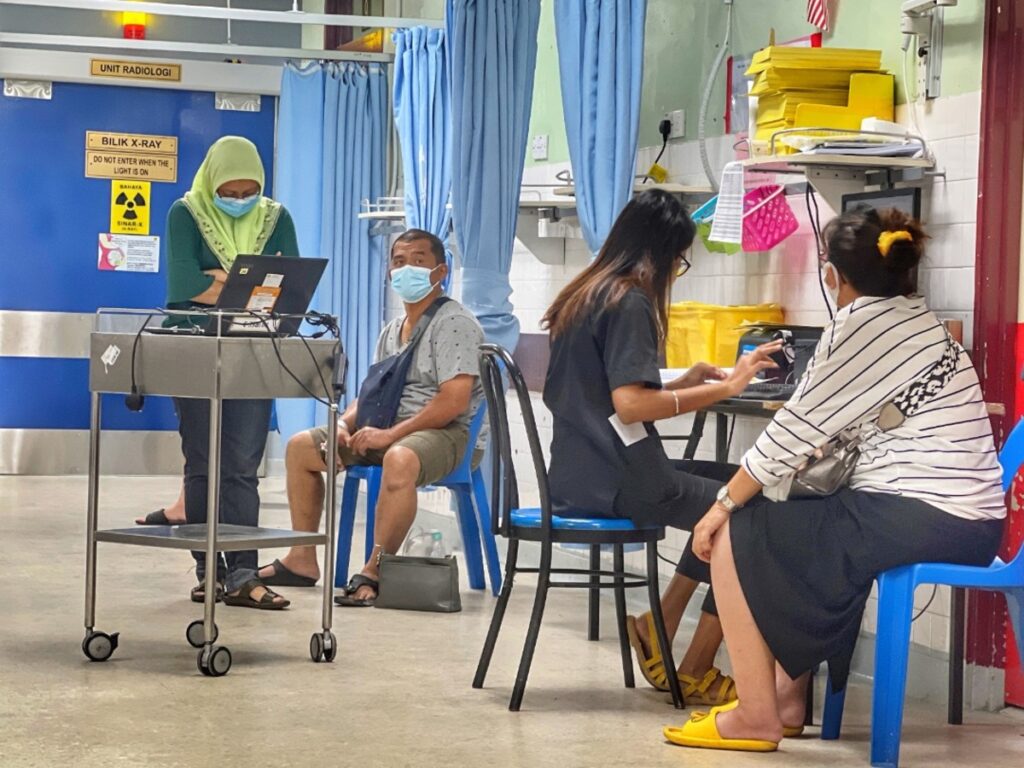
HRPB medical officer Dr Tess (pseudonym) stressed that the situation in her hospital could not be blamed on either the ETD or the ward.
“I think there’s not enough beds in the hospital; it’s a tertiary hospital covering the whole of Ipoh,” Dr Tess told CodeBlue in an interview.
“It’s memang overloaded unless they build another hospital and we have more staff to work, more funds, and everything, then only I think the situation will get better.”
She pointed out that even if patients are discharged from a ward to expedite admission of those stranded in the emergency department, the former will just return to the hospital if they were not fit for discharge in the first place.
“That is what is happening. It’s a vicious cycle. You either discharge them and admit these people, but they come back again. Or you keep them a bit longer until they’re really well and you discharge them, but patients will be stranded in ED.”
Dr Tess said the situation during the acute phase of the pandemic was “really bad”.
“That time, everybody painted frontliners as heroes, but I think now, we’re no one. Nobody bothers about frontliners. That’s how we feel. We feel under-appreciated for the amount of effort and work we do.
“They blame us – saying we’re not doing work good enough, fast enough, but seriously, we are trying our best. But we can’t do much with limited resources.”
‘We’re Not Trying To Play God, But…’
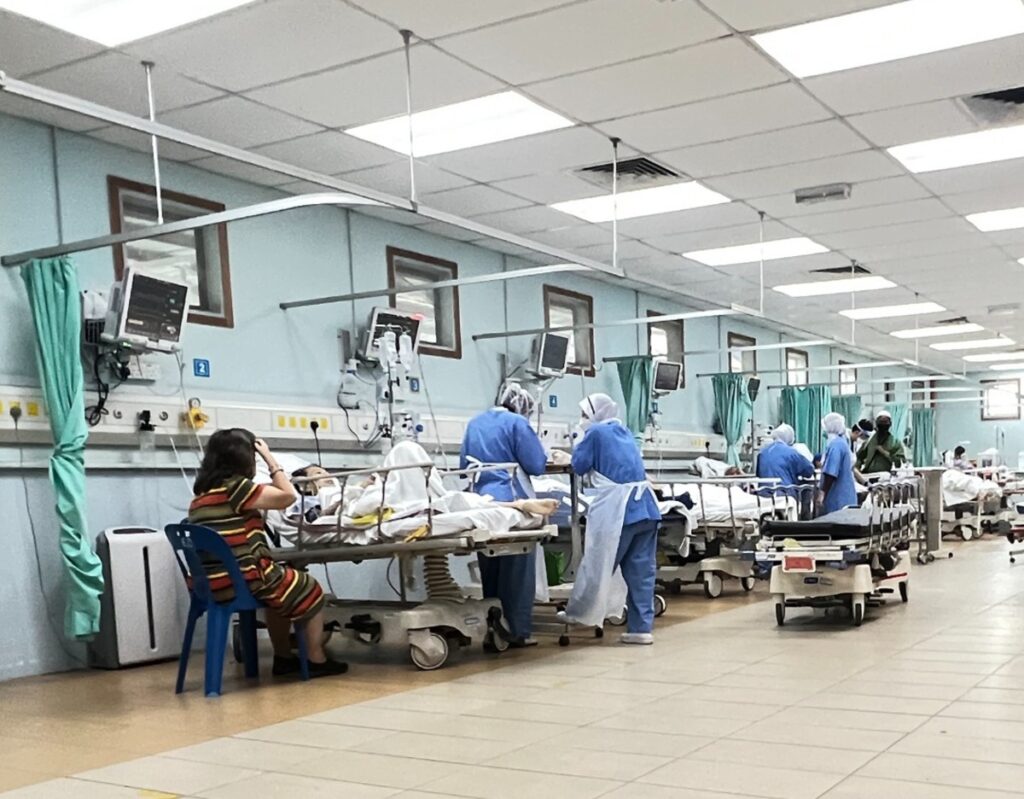
Dr Bob claimed that HRPB does not admit critically ill patients with “very low” chance of survival into ICU amid limited beds, such as brain-dead patients, those with multi-organ failure, and very elderly senior citizens; or even psychiatric hospital inpatients with mental illness, people with poor social support who live alone without family, and “vagabonds” like people who abuse alcohol or drugs.
“It’s a common practice here. This has been going on for many years,” he alleged. “It’s also the same at other public hospitals.”
Dr Bob said very old people who can’t get an ICU bed at HRPB have the “option” of going to a private hospital if they have health insurance or financial support from their family: “They go to private, they have better chance for survival because they have all the support in private…nursing care in private, they have more manpower compared to government side.”
Dr Tess stressed the hospital’s limited resources: “If we want to do the best, we have to see who really deserves it.”
“Who would you save if you had to make a choice?” she asked CodeBlue. “One is an 83-year-old gentleman, another one is just a 40 plus year old – he has two small kids and stuff like that. Who do you choose? There’s only one ICU bed.
“It is a difficult situation where doctors have to decide. We have to, like, batukan our hati and do this. It’s not that we purposely want the 83-year-old gentleman to die, but we can’t do much because there’s only one ICU bed. And we think he warrants [the bed] – the 40-something-year-old. We’re not trying to play god, but…”
Two other anonymous doctors – who previously served at HRPB – separately and independently corroborated with CodeBlue the purported practice across public hospitals of including non-clinical judgments in deciding who gets an ICU bed.
According to the Management Protocols in ICU published August 2012 by MOH’s medical development division together with the Malaysian Society of Intensive Care, the following factors should be taken into consideration in triaging to select patients for ICU admission when unit capacity is reached: diagnosis, severity of illness, age and functional status, co-morbid disease, physiological reserve, prognosis, availability of suitable treatment, response to treatment to date, recent cardiopulmonary arrest, and “anticipated quality of life”.
Dr Tess also dismissed KKMNow’s statistics on bed occupancy rates (BOR) at HRPB. When shown HRPB’s BOR published by the public MOH website on below 90 per cent utilisation of 33 ICU beds and below 75 per cent utilisation of non-critical care beds on a particular day, she simply said: “Impossible”.
“You can just go into the ward and look, they won’t have any empty beds. HDU is always full — 12 beds always full, full, full.”
Most Housemen Quit, Elderly Patients Coming In Very Sick

HRPB medical officer Dr Quinn (pseudonym) attributed the shortage of manpower in her hospital to housemen who resign from their jobs either midway of their training or immediately after completing housemanship.
“They have to take more doctors who really want to work in government because most of them quit halfway,” she told CodeBlue in an interview.
Like her colleagues, she observed an increase in the number of very ill patients coming to HRPB, most of whom need acute care beds.
“In our hospital, beds are limited.”
Dr Quinn said the general medical ward she is taking care of is full every day, but she tries her level best to accept cases as much as possible, with discharge of stable patients taking an average of three to five days.
When asked why she is seeing more sick patients now compared to pre-pandemic times, the medical officer cited missed follow-up appointments, non-compliance to medication regimens, or failing to pick up their medicines from the hospital.
“Some of them have severe pneumonia. They’re waiting until they’re very ill, then only they come to the hospital. Most of them are elderly.”
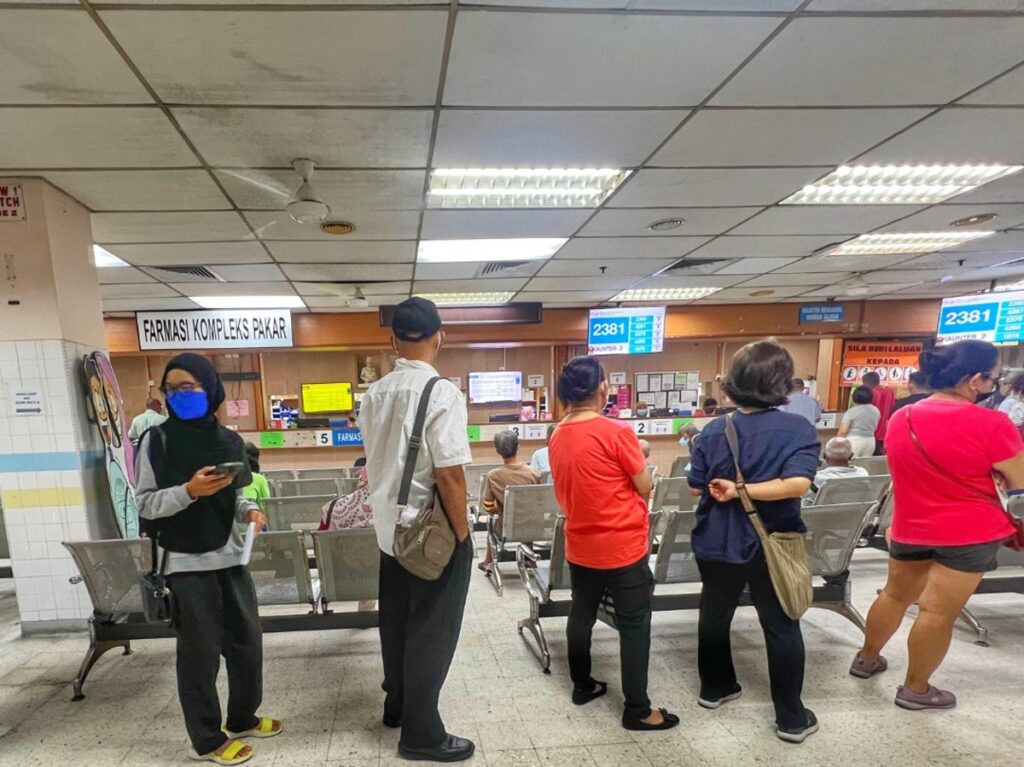
Dr Tess called for increased funding for public hospitals to provide better care for patients, pointing out that HRPB has limited stents for cardiology, for example.
“They say we got not enough funds, so we can’t use good quality stents,” she said.
She noted that even though HRPB has two invasive cardiac labs at its new women, children and cardiology complex (KWKK) to perform angiograms, only one is operational due to insufficient cardiologists – some three consultants, with the rest being trainees. Cardiologists from the public sector in Perak are only available at HRPB.
Dr Tess said Ipoh GH also does not have a cardiothoracic surgeon, so patients have to be sent to either Pulau Pinang Hospital or the National Heart Institute (IJN) in Kuala Lumpur, but she pointed out that the waiting list in Penang’s general hospital for a bypass is about a year.
‘Nobody Noticed When She Collapsed’
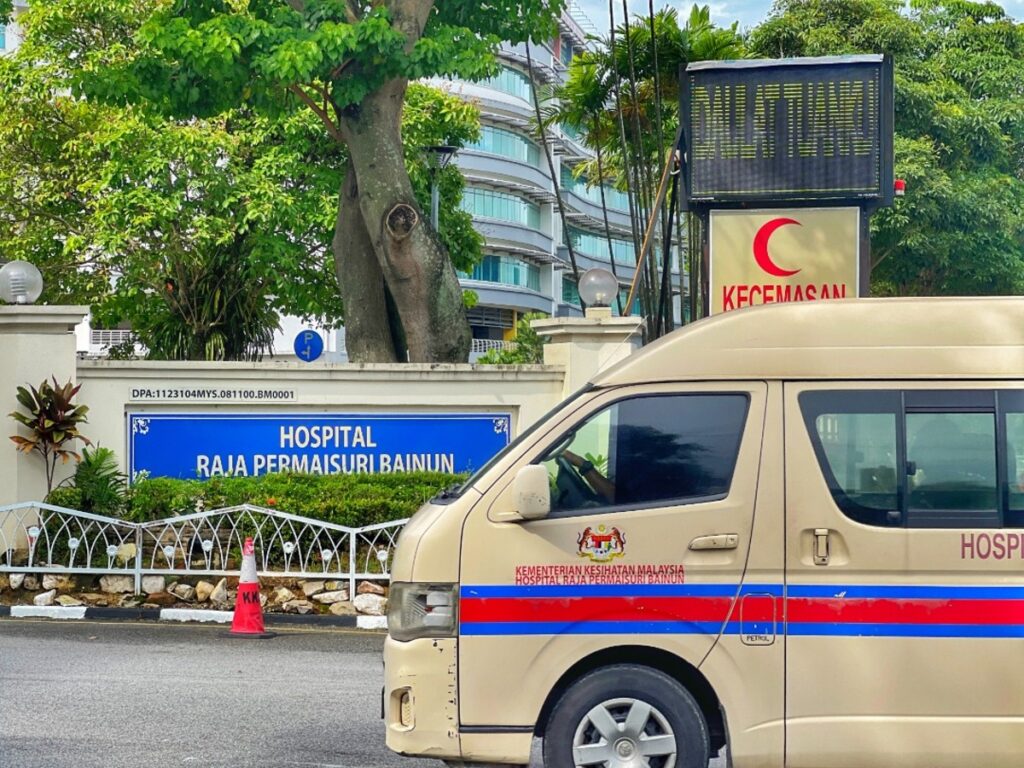
Dr Bob highlighted the disturbing case of an 81-year-old woman (Madam R), who died in a general medical ward at HRPB last July 9 after collapsing, allegedly without being noticed by ETD staff. Her direct cause of death was listed as septic shock secondary to urosepsis; her underlying conditions were diabetes, hypertension, and ischaemic heart disease.
Dr Bob explained that HRPB has tried to decongest the ETD by decanting patients who are considered stable to the old paediatric clinic, which is still registered as part of the emergency department.
“Unfortunately, some patients, we don’t know if they’re stable or not. Anything can happen,” he said, pointing out that the old paediatric clinic building has insufficient monitoring equipment and staff.
In Madam R’s case, she was transferred to the old paediatric clinic after arriving at the ETD on July 1 because doctors thought she was stable.
“During the time in the old paediatric clinic, she collapsed. Nobody noticed when she collapsed,” Dr Bob alleged.
“When they noticed it, they did CPR and managed to revive her, bring to the ward, but she was brain dead. Officially, she died in the ward, but nobody knew when her heart stopped in the old paediatric clinic.
“This type of thing is not supposed to happen because in kecemasan, the level of monitoring is supposed to be very, very strict compared to the general ward,” Dr Bob said, adding that monitoring in the ETD’s Red Zone is supposed to be one to one.
He said Madam R was only admitted into a general medical ward in the early hours of July 7, more than five days after entering the emergency department on July 1. She died two days after ward admission.
“The patient’s death was preventable if she had been properly monitored in the right place or if she had been admitted early to the ward,” Dr Bob opined.









